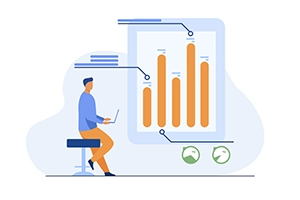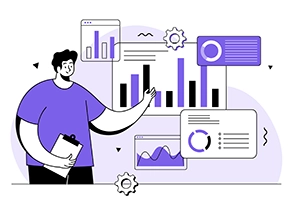Weekly marketing wisdom you can read in 5 minutes, for free. Add remarkable ideas and insights to your inbox, once a week, by subscribing to our newsletter.

How to Improve Conversion Rate by Understanding Website Traffic and Leads
Introduction: Why High Traffic Doesn’t Always Mean Success
Website visits are often treated as a sign of success, but the real goal is to improve the conversion rate. Seeing thousands of users each month can look impressive, yet high traffic doesn’t always mean genuine engagement or sales. Without meaningful conversions, those visitors represent potential rather than progress.
Many businesses focus on increasing traffic without understanding how to turn it into results. The difference between visibility and profitability lies in how effectively a website converts attention into action. Improving conversion rates starts with understanding user intent, clear messaging, and a seamless online journey.
Table of contents:
When Website Visits Don’t Equal Results
Traffic can come from organic search, paid ads, or social media, yet conversions may stay the same. This often points to a lack of alignment between what attracted users and what they find once they arrive. If content doesn’t meet expectations or the next step isn’t clear, most visitors will leave before taking action.
Your Lead Generation Services should focus on attracting the right audience, not just a large one. By connecting ad messaging, website copy, and user experience, you can guide visitors naturally towards conversion.
Why Businesses Still Rely on Traffic as a Metric
Traffic is easy to track and looks good in reports. It gives the impression of progress even when sales remain static. However, focusing too heavily on visitor numbers hides the real issue: how well your site turns that attention into leads.
Metrics like conversion rate, session duration, and bounce rate reveal much more about performance. Using tools like Google Analytics or your CRM platform, you can see exactly where visitors drop off and identify ways to improve conversion rate from those insights.
Understanding the Relationship Between Website Traffic and Conversions
What Counts as Website Traffic
Website traffic measures how many people visit your site within a specific period. It’s often segmented by channel, such as organic search, paid ads, social media, or referrals. Each source tells a different story about user intent. Someone arriving from an informational search may behave differently from a visitor who clicked a targeted ad.
High traffic numbers mean little unless they bring the right type of audience. Targeting users who are actively looking for your product or service leads to more meaningful results.
What a Lead Conversion Really Means
A conversion happens when a visitor takes a defined action, such as completing a contact form, requesting a quote, or signing up for a newsletter. It’s the step that turns curiosity into opportunity.
By tracking these actions, you’ll understand which marketing channels and website elements perform best. Analysing this data allows you to refine campaigns and improve conversion rate over time.
Why Quality of Visitors Matters More Than Quantity
A smaller audience that’s ready to engage will always outperform a large, unfocused one. When your traffic matches your buyer profile, conversion rates rise naturally. Effective targeting through Search Engine Optimisation ensures your content reaches the right people.
Instead of chasing bigger numbers, focus on user intent and create landing pages that speak directly to your audience’s needs.
Why Website Traffic Doesn’t Always Convert into Leads
Poor User Experience and Confusing Navigation
Even if you attract the right audience, a poor user experience can derail performance. Slow load times, cluttered design, or missing information all cause frustration. Simplifying your layout and making calls to action visible will instantly improve conversion rate by removing unnecessary barriers.
Every second counts when users decide whether to stay or leave. Clean design and fast performance are often more persuasive than flashy visuals.
Weak Calls to Action and Unclear Value
A strong call to action is essential for moving users through your sales funnel. Visitors should instantly know what to do next and why it benefits them. Phrases like “Get a Free Quote” or “Speak to an Expert Today” give direction and urgency.
Equally, your value proposition must be specific. Users want to know what makes your solution better or faster than others. Clear, confident messaging increases trust and action.
Mismatch Between Audience Intent and Offer
If your ads or search keywords target the wrong audience, you’ll generate clicks but few conversions. Every campaign should be aligned with the visitor’s intent and the content they see upon arrival.
Analysing your data can show whether your targeting is attracting buyers or browsers. Adjusting messaging to match intent helps you improve conversion rate while maintaining efficient ad spend.
How to Improve Conversion Rates Without Increasing Traffic
Simple Ways to Improve Conversion Rate Through Better Relevance
Relevance drives conversions more than reach. Crafting messages that speak directly to your audience’s problems makes them more likely to engage. Personalised landing pages, segmented email campaigns, and service-specific content create pathways that turn visitors into leads.
Start by identifying which pages or campaigns attract the most qualified users. Build on those insights rather than broadening your reach aimlessly.
Simplify User Journeys to Reduce Drop-Off
Each extra click or form field adds friction. Simplify the process to encourage action. If you run service-based campaigns, ensure enquiry forms are short and intuitive. Visual cues like directional arrows or button colours can also influence engagement.
By refining your site navigation and removing distractions, you’ll naturally improve conversion rate without increasing traffic volume.
Testing Methods That Improve Conversion Rate Over Time
Continuous testing is the most reliable way to strengthen results. Experiment with different headlines, layouts, and CTAs to see what performs best. Small changes, such as altering button placement or updating testimonials, can have a measurable effect.
Track these results monthly to identify patterns. A/B testing provides clarity about what works, helping you make informed decisions rather than assumptions.
Measuring What Really Matters
The Metrics That Reflect Business Growth
Focus on metrics that show tangible outcomes. Conversion rate, cost per lead, and lead-to-sale ratio all reveal how well your marketing translates into revenue. While impressions and clicks have value, they don’t prove business growth.
Evaluating data this way keeps your strategy grounded in performance rather than vanity.
Using Conversion Data to Guide Future Strategy
Every conversion tells you something about your audience. By analysing which sources and pages deliver results, you can allocate more budget to high-performing areas. This approach keeps campaigns efficient and scalable.
Over time, these insights shape a stronger foundation for your digital marketing. Instead of reacting to trends, your decisions come from evidence.
Summary
Turning Traffic into Trust and Sustainable Leads
Improving conversion rates isn’t about chasing bigger traffic numbers. It’s about understanding intent, relevance, and simplicity. When your website answers the right questions and provides clear value, visitors turn into loyal customers.
Each refined step, from user experience to data analysis, builds a path toward sustainable growth. Focus on clarity, consistency, and continual improvement, and every visit becomes an opportunity to strengthen your business.






